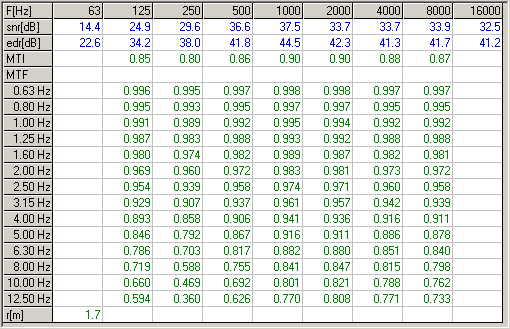
In the calculation of the MTF the impulse response may be truncated. This follows the same rule as for the reverberation time calculation. For details, see the Advanced calculation options... section.
However, there is one important exception. If  is selected in the dialog box as
shown below, the impulse response will not be truncated. This is because if
truncating the impulse response, the background noise influence would not be
correctly considered (for more information see the Influence calculated from calibrated
measurement section below).
is selected in the dialog box as
shown below, the impulse response will not be truncated. This is because if
truncating the impulse response, the background noise influence would not be
correctly considered (for more information see the Influence calculated from calibrated
measurement section below).

The MTF is determined by FFT of the filtered and truncated impulse response, and the values at the exact 1/3-octave modulation frequencies specified are found by linear interpolation. This is a fast and very accurate method for all but extraordinary short impulse responses, and for these the modulation reduction for speech transmission is negligible anyway.
If MTF is checked in the check box, it will be displayed for the various octave bands and modulation frequencies in the table shown below.

Note that the MTF values are linear. In order to convert to dB you have to compute 20*log10, even though it is in the intensity domain.
MTI is a transmission index specific for each octave band, calculated based on MTF values in that octave band as described in in IEC-60268-16. The calculation of the speech transmission indices are subsequently based on the MTI.

The standard MTF and MTI  output shown above in WinMLS are
according to the original definitions [IEC-60268-16 1.ed], the basis for STI and
RASTI calculations. No auditory masking , gender specific weighting or hearing
threshold is taken into account. They are, however, noise corrected if
specified.
output shown above in WinMLS are
according to the original definitions [IEC-60268-16 1.ed], the basis for STI and
RASTI calculations. No auditory masking , gender specific weighting or hearing
threshold is taken into account. They are, however, noise corrected if
specified.
The revised MTF and MTI  output shown above are computed according to IEC-60268-16 3.ed.
with auditory masking, gender specific weight factors and hearing threshold (if
the measurement is calibrated) taken into account.
output shown above are computed according to IEC-60268-16 3.ed.
with auditory masking, gender specific weight factors and hearing threshold (if
the measurement is calibrated) taken into account.